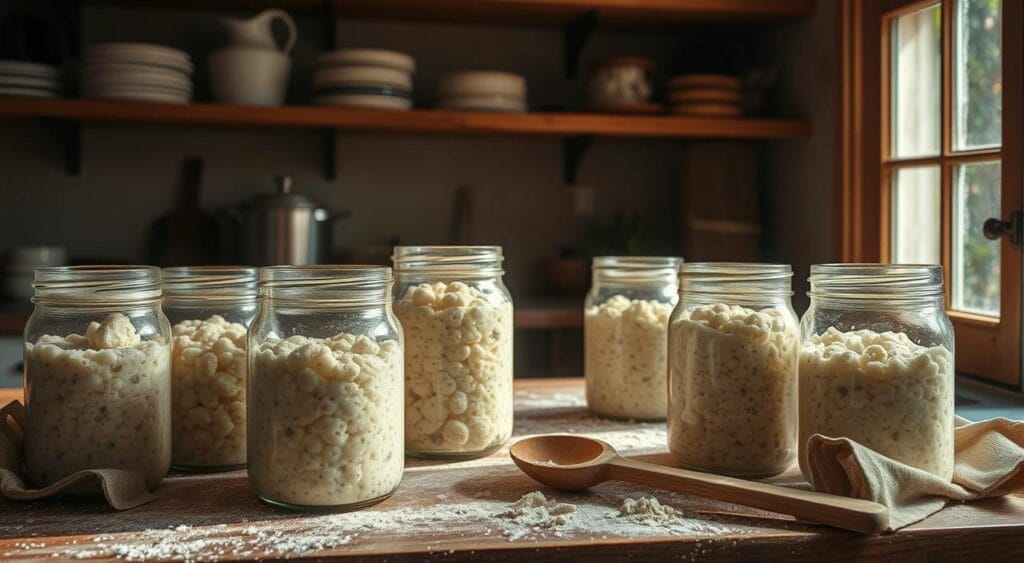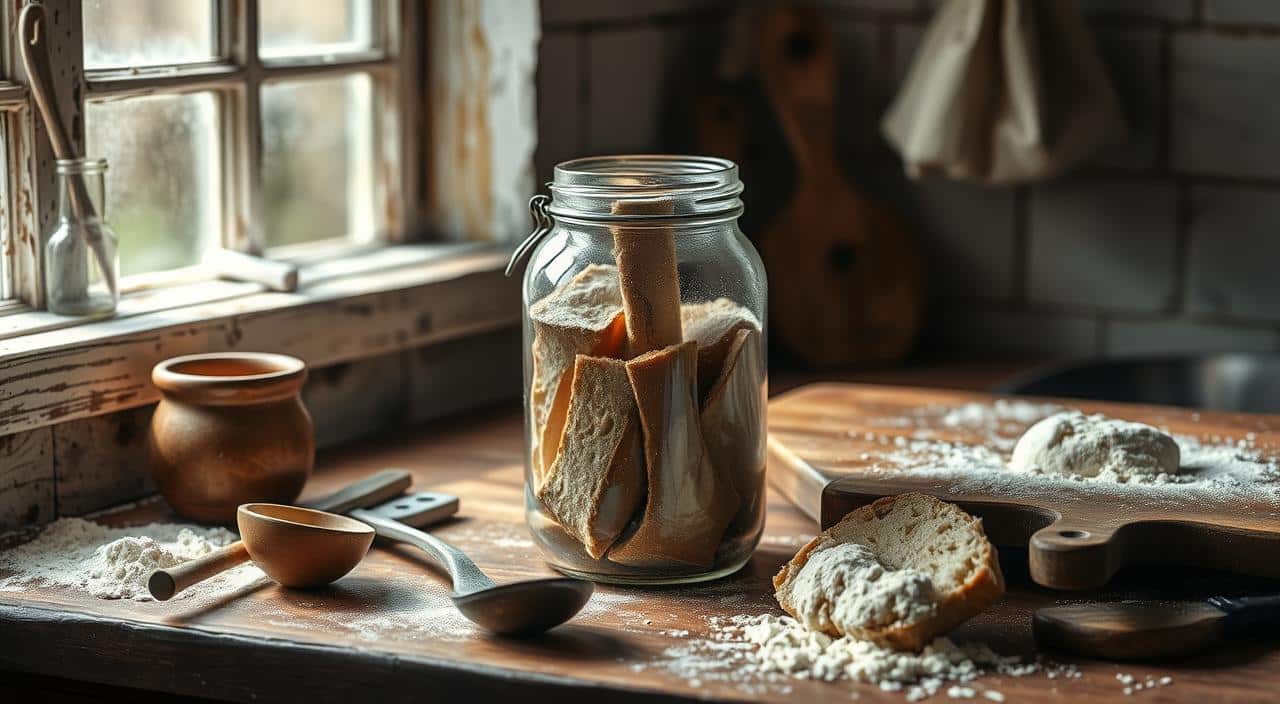Jump to:
Estimated reading time: 12 minutes
Table of contents
Ever wondered what to do with that jar of sourdough discard in your fridge? How long can you keep it before it goes bad? Sourdough is a gem for home bakers. But knowing how long it lasts is crucial to avoid waste.
This guide will cover the factors that affect sourdough discard’s shelf life. We’ll talk about the best ways to store it and creative recipes to use it in. Whether you’re new to sourdough or a pro, learning about sourdough will elevate your baking.
We’ll look at how temperature, feeding, and acidity levels affect its shelf life. You’ll discover how to keep it fresh in the fridge or freezer. We’ll also show you how to tell if it’s gone bad. And, we’ll share tasty recipes that use sourdough , like pancakes and bread.
Key Takeaways
- It is the part you remove to keep your starter healthy.
- Storage temperature, how often you feed it, and its acidity level affect its shelf life.
- Storing it in the fridge or freezer can make it last longer.
- Look out for an off smell, mold, or color changes to know it’s gone bad.
- You can use it in many recipes, like bread and pancakes.
Understanding Sourdough Discard
When you start with it, you’ll soon learn about sourdough starter discard. It’s key to making sourdough, and knowing its importance will help you use your starter well.

What is Sourdough Discard?
Sourdough discard is the part of your starter you throw away when you feed it. Feeding your starter means adding fresh flour and water. But, you must get rid of some starter to keep it healthy and not too big.
This discarded sourdough is still good to use. It adds a special taste and texture to your bread. Bakers get creative with it, making sure nothing is wasted.
Why Do You Need to Discard Sourdough Starter?
There are good reasons to discard some of your sourdough starter:
- It keeps the ingredients balanced, keeping your starter healthy and active.
- It stops the starter from getting too big and hard to handle.
- It controls the starter’s acidity, so it doesn’t get too sour or taste bad.
By throwing away some starter, you make room for new flour and water. These give the wild yeast and bacteria what they need to grow. This keeps your starter perfect for making tasty sourdough bread and other treats.
Embrace the art of sourdough discard and discover the many ways it can enhance your baking experience.
Factors Affecting Sourdough Discard Shelf Life
Storing sourdough discard right is key to keeping it fresh. Knowing what affects its shelf life helps you use it well and avoid waste. Let’s look at the main things that change how long sourdough discard lasts.
Storage Temperature
Temperature is a big factor in how long you can store sourdough discard. Keeping it in a cool place, like the fridge, makes it last longer than at room temperature. Cooler temperatures slow down the fermentation, keeping the discard from getting too acidic and spoiling fast.
Frequency of Feeding
How often you feed your sourdough starter affects its discard’s shelf life. Feeding it regularly means you get fresher discard that lasts longer. Feeding adds new flour and water, balancing the acidity and keeping the wild yeast and bacteria healthy.
| Feeding Frequency | Discard Shelf Life |
|---|---|
| Daily | 1-2 weeks |
| Every 2-3 days | 3-5 days |
| Weekly | 1-2 days |
Acidity Level
The acidity of your sourdough also affects its shelf life. As the starter eats the flour and makes lactic acid, it gets more acidic. This can make it taste bad or too sour for recipes.
To keep the acidity in check and make the discard last longer, you should throw away some starter before feeding it. This keeps the acidity balanced and the starter healthy.
Understanding what affects sourdough discard shelf life helps you store and use it better. This way, your discard stays fresh for your favorite recipes.
How Long Is Sourdough Discard Good For?
Understanding the shelf life of sourdough discard is key. It depends on storage, acidity, and contaminants. You can safely store it for a while.
Sourdough can last up to a week in the fridge. This is great for those who bake often. It keeps the discard ready for recipes all week.
Freezing is another way to store it for longer. In a sealed bag or container, it can last 2-3 months. This is ideal for less frequent users or saving for later.
Always check your sourdough discard for spoilage signs. If you see bad smells, mold, or color changes, throw it away and start fresh.
Here are tips for keeping your sourdough discard fresh:
| Storage Method | Shelf Life | Tips |
|---|---|---|
| Refrigerator | Up to 1 week | Store in an airtight container, labeled with the date. |
| Freezer | 2-3 months | Portion into usable amounts, store in freezer bags or containers, and label with the date. |
Knowing how long sourdough discard lasts and how to store it helps. You can use it wisely and avoid waste. Enjoy making delicious sourdough treats.
Storing Sourdough Discard
Proper storage is key to keeping your discard fresh and usable. There are several ways to store it, each with its own benefits for different uses and timeframes.
Refrigerator Storage
Storing sourdough discard in the refrigerator is a common method. It slows down fermentation, keeping the discard from getting too acidic. Here’s how to do it:
- Put the discard in a clean, airtight container.
- Write the storage date on the container.
- Keep the container in the fridge for up to 1 week.
When you want to use the discard, take it out of the fridge and let it warm up before adding it to your recipe.
Freezer Storage
If you won’t use your sourdough discard in a week, freezing is a great choice. Freezing stops the discard from getting too acidic or tasting bad. Here’s how to freeze it:
- Put the discard into smaller, freezer-safe containers or bags.
- Mark each container or bag with the date and discard amount.
- Put the containers or bags in the freezer for up to 3 months.
To use the frozen discard, thaw it in the fridge overnight. Then, let it warm up before adding it to your recipe.
Room Temperature Storage
Storing your sourdough discard at room temperature isn’t recommended for a long time. But, it’s okay for up to 24 hours if you’re using it soon. Here’s how:
- Put the discard in a clean, airtight container.
- Cover it with a lid or plastic wrap.
- Keep it at room temperature for 24 hours or less.
Remember, storing at room temperature can make the discard ferment fast and get too acidic. So, use it quickly to keep your baked goods tasting good.
Remember, the key to successful sourdough starter discard storage is to pick the method that works best for you. This ensures you can use the discard while it’s still fresh and tasty.
Signs of Spoiled Sourdough Discard
Storing sourdough discard for a while is okay, but knowing when it’s bad is key. You need to spot signs to avoid using bad discard in your baking. Here are signs that your sourdough discard has expired and should be thrown away:
Unusual Odor
A bad smell is a clear sign of spoiled sourdough discard. Fresh discard smells slightly sour but nice. But, a strong acetone smell means it’s gone bad and should be thrown away right away. Trust your nose to tell you when sourdough discard has expired.
Mold Growth
Seeing mold on your sourdough discard means it’s spoiled. Mold can be green, blue, or black and might be fuzzy or slimy. If you see mold, throw away the whole batch to keep your kitchen clean.
Discoloration
Discoloration can also mean yours is bad. It should look creamy and even. Pink, orange, or grey spots mean harmful bacteria might be growing. In this case, it’s important to throw away the discard to keep your kitchen safe.
| Sign of Spoilage | Description | Action Required |
|---|---|---|
| Unusual Odor | Strong acetone smell or unpleasant odors | Discard immediately |
| Mold Growth | Visible mold in various colors (green, blue, black) | Dispose of the entire batch promptly |
| Discoloration | Pink, orange, or grey discoloration | Discard to prevent health risks |
Keep an eye out for these signs to make sure you use fresh, safe sourdough discard. If you’re unsure, it’s best to be safe and follow proper sourdough discard disposal. This keeps your baked goods quality and safe.
Uses for Sourdough Discard
If you’re into sourdough baking, you might have more discard than you know what to do with. Don’t throw it away! There are many ways to use it, from making bread to pancakes. Using discard sourdough starter helps reduce waste and adds a unique taste to your food.
Sourdough Discard Recipes
Exploring recipes made for it is a great way to use it. You’ll find recipes for both savory and sweet treats. Some popular ones include:
- Sourdough discard crackers
- Sourdough discard pizza crust
- Sourdough discard waffles
- Sourdough discard biscuits
- Sourdough discard scones
These recipes let you try new flavors and textures in your baking.
Sourdough Discard Bread
You can also add it to your bread recipes for extra flavor. Many bakers say it makes their bread taste and feel better. Here are tips for using it in bread:
- Replace some flour and water with an equal amount of discard.
- Change the rising time as needed, since discard can speed up fermentation.
- Try different mixes of discard and fresh flour to find what you like best.
Sourdough Discard Pancakes
It is perfect for pancakes. Its tangy taste goes well with maple syrup, making a tasty breakfast. Just swap some flour and liquid in your pancake recipe with discard. You’ll get fluffy pancakes that everyone will love.
“Sourdough discard is a baker’s best friend. It’s versatile and can be used in many recipes, from bread to pancakes. Don’t waste it – get creative and enjoy sourdough’s tangy flavor!”
Tips for Managing Sourdough Discard
Managing it is key to keeping your starter healthy and active. By following simple tips and storage methods, you can make sure your discard doesn’t go to waste. Here are some important strategies to remember:
Regular Feeding Schedule
Feeding your sourdough starter regularly is crucial. This keeps you with a steady supply of fresh discard for recipes. It also keeps your starter healthy and active, avoiding acidity or weakness.
Here are tips for a regular feeding schedule:
- Feed your starter at the same time every day, when it’s most active.
- Adjust how often you feed based on your starter’s temperature and activity. Feed more often in warm places or when it’s very active.
- Always use the same ratio of flour and water for feeding. This keeps the yeast and bacteria balanced.
Proper Storage Containers
Choosing the right containers for your discard is vital. Glass jars with tight lids are great because they let you see the contents and keep air and moisture out. Don’t use plastic as it can absorb smells and might release chemicals into your discard.
Here are tips for storing sourdough discard:
- Use clean, sterile jars to stop unwanted bacteria or mold from growing.
- Label your jars with the discard’s collection date. This helps you know when it was made and use it before it spoils.
- Put your discard in the fridge or freezer, depending on when you’ll use it. Discard in the fridge lasts a week, and in the freezer, several months.
By using these tips and storage methods, you can manage your discard well. This ensures it stays a valuable ingredient for your baking.
Sourdough Discard Disposal
Handling it right is key to keeping your kitchen clean and safe. If your discard smells bad, has mold, or looks off, it’s time to get rid of it safely.
You can throw away bad sourdough discard or add it to your compost if your system can take it. This is a green way to let the discard break down and enrich the soil.
Don’t pour a lot of it down the drain. It can clog your pipes and harm your plumbing. Instead, use a spatula or spoon to put it in the trash or compost.
“Proper sourdough discard disposal is key to maintaining a clean and safe kitchen environment while also being mindful of the environment.”
Here are some tips for responsible sourdough discard disposal:
- Dispose of spoiled discard in the trash or compost bin
- Avoid pouring large amounts of discard down the drain
- Use a spatula or spoon to scrape discard into the appropriate receptacle
- Consider composting discard if your system can handle fermented products
Follow these tips to dispose of your sourdough discard safely and responsibly. This way, you won’t harm your kitchen or the environment.
Frequently Asked Questions
How long can I keep sourdough discard?
It can be kept in the refrigerator for up to 1-2 weeks. Over time, it may become more acidic as the natural fermentation continues, which can alter the flavor in recipes. After about two weeks, the discard may start to develop an off flavor, so it’s best to use or refresh it within that timeframe.
Can sourdough discard be stored at room temperature?
For short periods (up to 24 hours), It can be kept at room temperature. However, it’s best to refrigerate it if you’re storing it for longer than a day to prevent spoilage or over-fermentation. Refrigeration slows down the fermentation process and helps preserve the flavor and texture.
Can you freeze sourdough discard?
Yes, It can be frozen to extend its shelf life. Place it in an airtight container, and it can last in the freezer for up to 3 months. Thaw it in the refrigerator before using it in recipes. Freezing may slightly alter the texture, but it’s still usable for baked goods.
How should I store sourdough discard to keep it fresh longer?
To keep it fresh, store it in a sealed container in the refrigerator. Stir it occasionally if storing for more than a few days, and avoid exposing it to other strong odors in the fridge. Using a clean container each time you add fresh discard can also help keep it from spoiling.
Conclusion
Knowing how long sourdough lasts and how to store it is key for home bakers. This knowledge helps you use your leftover starter well. It ensures your discard is always ready for different recipes.
It’s important to spot signs of spoilage like bad smells, mold, or color changes. These signs mean the sourdough is not good to use anymore. Storing it in the fridge, freezer, or at room temperature helps. This way, you can use it before it goes bad and enjoy its unique taste and texture.
This guide gives you the info and tips to handle your discard well. By using it in your baking and trying out various recipes, you can improve your baking skills. You’ll make tasty, new treats that show off the great qualities of this ingredient.






